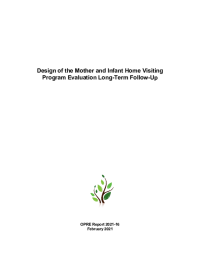Design of the Mother and Infant Home Visiting Program Evaluation Long-Term Follow-Up

 Children develop fastest in their earliest years, and the skills and abilities they develop in those years help lay the foundation for future success. Early negative experiences can contribute to poor social, emotional, cognitive, behavioral, and health outcomes both in early childhood and in later life. One approach that has helped parents and their young children is home visiting, which provides individually tailored support, resources, and information to expectant parents and families with young children. Many early childhood home visiting programs work with low-income families to help ensure the healthy development and well-being of their children.
Children develop fastest in their earliest years, and the skills and abilities they develop in those years help lay the foundation for future success. Early negative experiences can contribute to poor social, emotional, cognitive, behavioral, and health outcomes both in early childhood and in later life. One approach that has helped parents and their young children is home visiting, which provides individually tailored support, resources, and information to expectant parents and families with young children. Many early childhood home visiting programs work with low-income families to help ensure the healthy development and well-being of their children.
In 2010, Congress authorized the Maternal, Infant, and Early Childhood Home Visiting (MIECHV) Program by enacting section 511 of the Social Security Act, 42 U.S.C. § 711, which also appropriated funding for fiscal years 2010 through 2014. Subsequently enacted laws extended funding for the program through fiscal year 2022. The program is administered by the Health Resources and Services Administration (HRSA) in collaboration with the Administration for Children and Families (ACF) within the U.S. Department of Health and Human Services (HHS). The initiation of the MIECHV Program began a major expansion of evidence-based home visiting programs for families living in at-risk communities. The legislation authorizing MIECHV recognized that there was considerable evidence about the effectiveness of home visiting, but also required an evaluation of MIECHV in its early years. That evaluation became the Mother and Infant Home Visiting Program Evaluation (MIHOPE). The overarching goal of MIHOPE is to learn whether families and children benefit from MIECHV-funded early childhood home visiting programs, and if so, how. MIHOPE includes the four evidence-based home visiting models that 10 or more states chose in their fiscal year 2010-2011 plans for MIECHV funding: Early Head Start – Home-based option, Healthy Families America, Nurse-Family Partnership, and Parents as Teachers. From October 2012 to October 2015, a total of 4,229 families entered the study.
Given the positive effects found in previous long-term studies of home visiting and previous findings that the benefits of home visiting outweigh the costs only after children enter elementary school, ACF and HRSA initiated plans to design long-term follow-ups with the families who are participating in MIHOPE. MDRC is conducting this work in partnership with Columbia University and Mathematica Policy Research. ACF and HRSA were interested in ensuring that any additional follow-up build on information from the earlier waves of data collection to the greatest extent possible, and that any proposed follow-up points build on one another. This long-term follow-up phase is called MIHOPE-LT. This report presents the proposed design for potential long-term follow-ups with MIHOPE families through the time when their children are in high school. The report also presents the detailed design for the follow-up that is occurring when children are in kindergarten.
Primary Research Questions
The four primary research questions that the long-term follow-ups were designed to address are:
- What are the long-term effects of being assigned to receive evidence-based home visiting for families who enrolled in MIHOPE?
- Are the long-term effects of home visiting larger for some families than for others?
- What are the pathways through which home visiting affects families’ longer-term outcomes?
- How do the monetary benefits of home visiting compare with its costs over the long term?
Purpose
Several previous studies of the four home visiting models included in MIHOPE have provided information on the long-term effects of home visiting programs. MIHOPE-LT can expand this body of evidence. The previous studies had relatively small samples, were model-specific, and did not examine the same outcomes in the same way across models, making it difficult to summarize across studies and models. In contrast, MIHOPE-LT will measure the same outcomes for all four evidence-based models included in MIHOPE. In addition, most of the previous long-term studies were completed many years ago. Home visiting programs have changed over time, both because of statutory requirements for federal funding through the MIECHV Program and because programs and models are continually evolving through quality-improvement efforts. Moreover, the context in which the programs operate, and the program participants, have also changed. As programs evolve and program context changes, additional evaluation can determine whether programs continue to be effective in meeting their goals.
Key Findings and Highlights
MIHOPE estimated the effects of MIECHV-funded early childhood home visiting programs on family and child outcomes around the time children were 15 months of age and found small positive effects for families across several outcome areas. (See Charles Michalopoulos, Kristen Faucetta, Carolyn J. Hill, Ximena A. Portilla, Lori Burrell, Helen Lee, Anne Duggan, and Virginia Knox, Impacts on Family Outcomes of Evidence-Based Early Childhood Home Visiting: Results from the Mother and Infant Home Visiting Program Evaluation, OPRE Report 2019-07.) Contact with the MIHOPE families was maintained via short surveys that were completed around the time children were 2.5 and 3.5 years of age.
The MIHOPE-LT study team identified the four primary research questions listed above and proposed a study design that could be used to answer these questions. A follow-up when children are in kindergarten began in January 2019, and the plans for this data collection are discussed in detail in this report. Three other potential follow-up time points based on the participating child’s expected progression through school were also identified: third grade, middle school, and high school. Obtaining information about families’ well-being over time might be particularly important for answering the question of how the monetary benefits of home visiting compare with its costs, because benefits may continue to accrue as children get older. This report does not present detailed plans for follow-ups past kindergarten. Detailed study designs would need to be developed in the future if follow-up at later time points was to be conducted.
Methods
MIHOPE included 88 local home visiting programs in 12 states. More than 4,200 women who were pregnant or had children younger than six months of age were randomly assigned to a MIECHV-funded home visiting program or to a control group who received information about other appropriate services in the community.
For the kindergarten follow-up, data collection methods are similar to those used for the MIHOPE follow-up that occurred when children were 15 months of age. Specifically, information is being gathered from a structured interview conducted with mothers. The study is also drawing on video-recorded interactions of mothers and children playing with toys; interviewer observations of parental warmth and children’s self-regulation; direct assessments of children’s language skills, math skills, and executive function; direct assessments of mothers’ executive function; state administrative child welfare data; state school records data; federal administrative Medicaid data; federal employment and earnings data from the National Directory of New Hires; and a survey conducted with children’s teachers.






